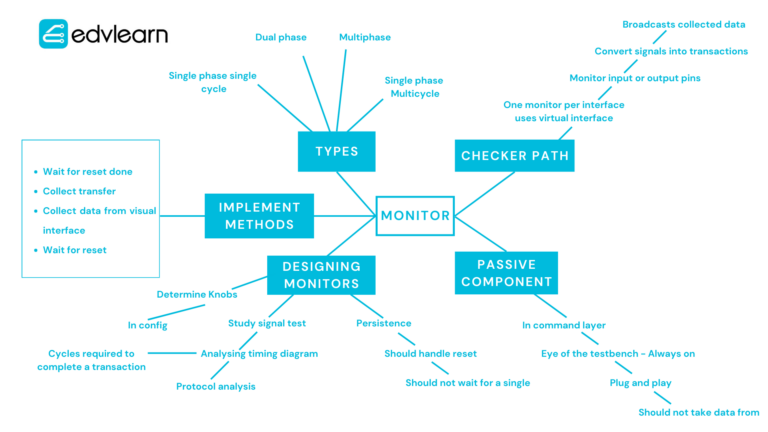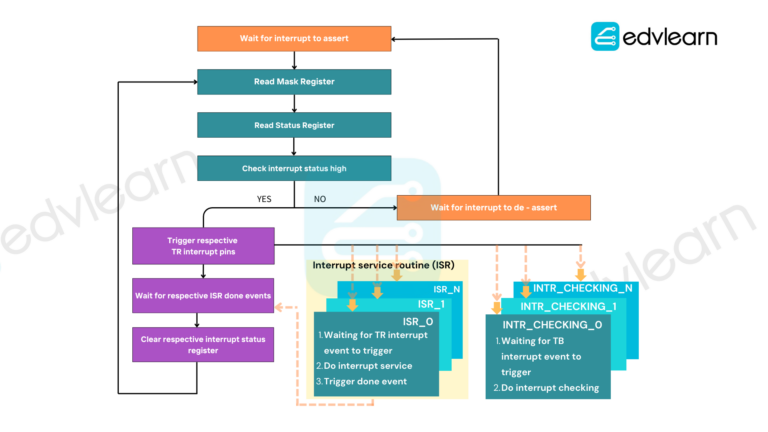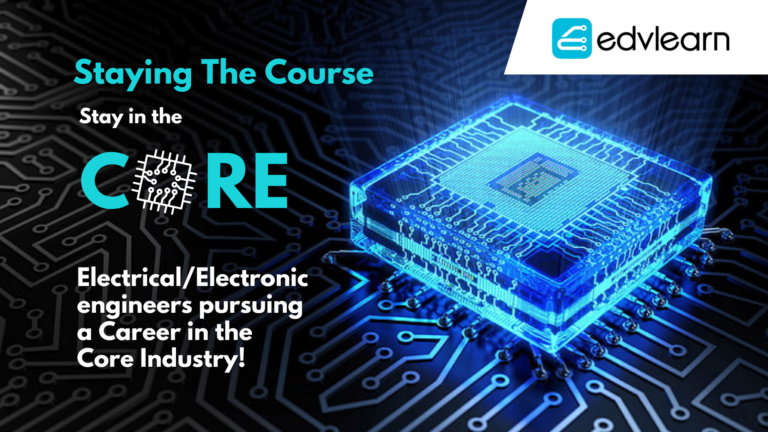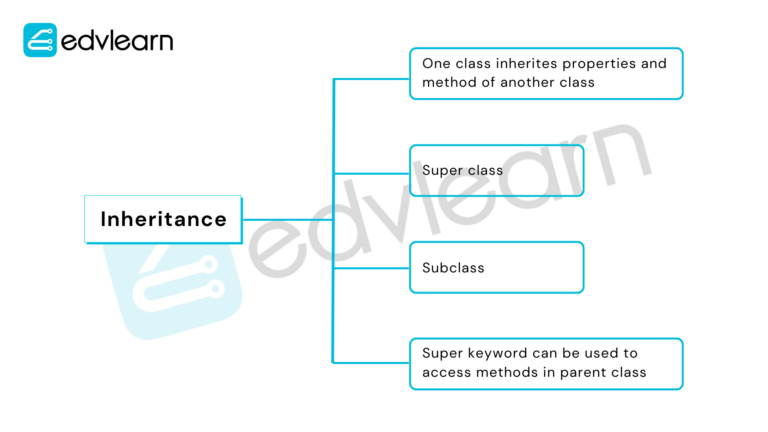Digital Design and Verification
- Last Updated 01/2025
- English
- English[Integrated]
This foundational course aims to investigate what a chip is , why companies would want to make them, and their evolution over the decades.
The course begins with a brief history of the chip, and then covers chip IO , binary system , arithmetic and its representation, combinational and sequential circuit and basic Verilog constructs. We then give a detailed introduction to digital design and digital design verification.
We end the course with a debugging challenge wherein a digital design with bugs is given and students need to find bugs and report through the portal. As the bugs are reported, updated digital design is given providing a real industry digital verification exposure.
What will you learn?
-
What is chip, Why a company would develop a chip
- Digital Fundamentals
- Evolution of chip, Types of chips, Bus interface
- HDL Design flow & Synthesis
- Role of Verification, Types of verification
- Functional Verification
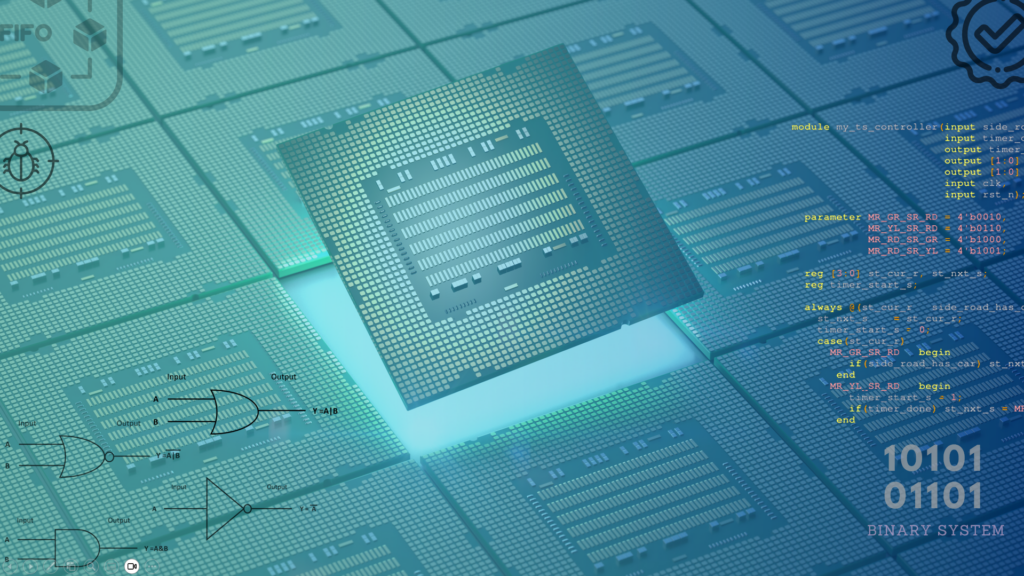
Price Rs.7400 (inclusive of GST)
Instructor Vinod Kumar Gopinath
Duration 8 Weeks
Chapters 14
Learners 2500 students
This Course Includes
- 5 hours on-demand video
- Lab assignments
- Quizzes and Elaborate Questions
- Certificate of completion
Certificate for completion (80%):
The certificate will state:
“This is to certify that (Name) has actively participated
in the course ‘Digital Design and Verification’ and completed a major portion of the curriculum”
Certificate for completion (95% or more):
The certificate will state:
“This is to verify that(Name) has successfully
completed the course ‘Digital Design and Verification'”
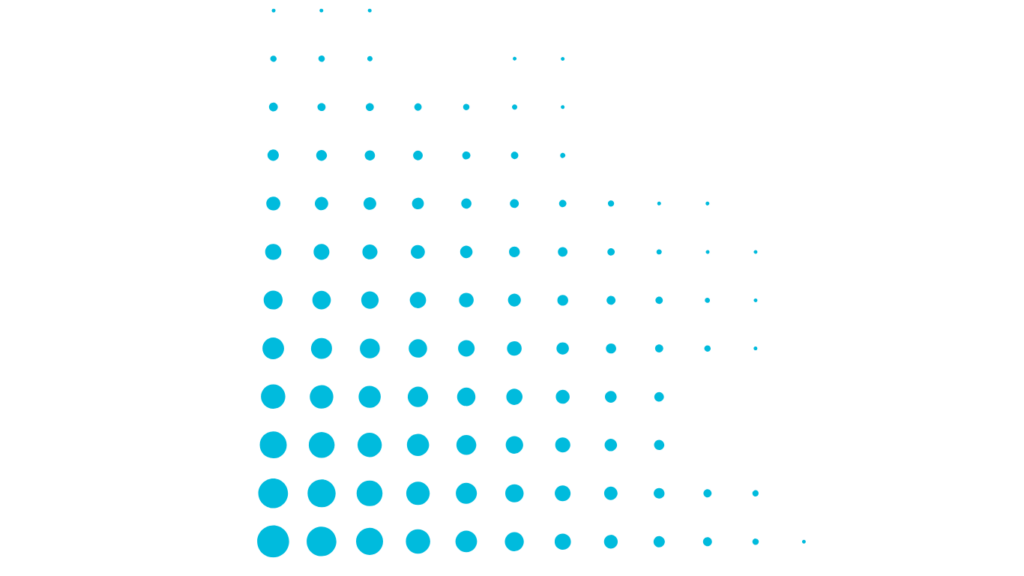

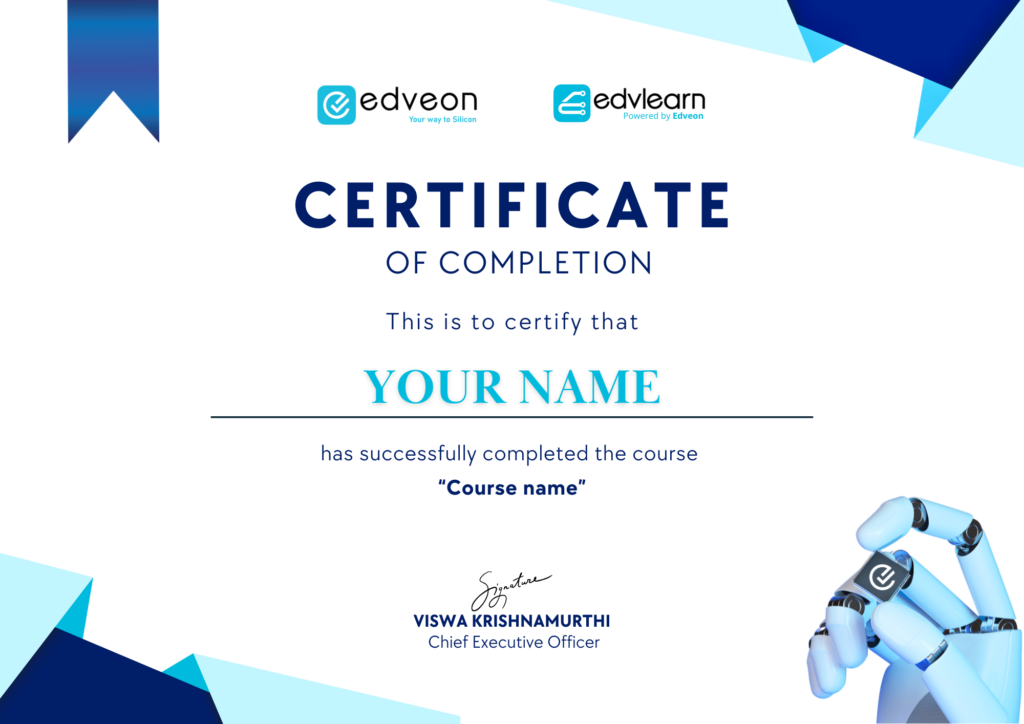
Course Curriculum
14 Chapters 74 Lectures 5h total length
Preview
Video Preview with Icon What is a Chip? _____________________________________________________________________________________________________________ 7 lectures 18min
What is a Chip? _____________________________________________________________________________________________________________ 7 lectures 18min
- Introduction - --------------------------------------------------------------------------------------------------------02:12
- Discrete and continuous signals----------------------------------------------------------------------------------------02:14
- Digitization-----------------------------------------------------------------------------------------------------------02:27
- Analog and digital Circuits - -------------------------------------------------------------------------------------------02:05
- Digital part of the chip - -----------------------------------------------------------------------------------------------01:53
- Transistors-----------------------------------------------------------------------------------------------------------03.50
- Building digital systems with transistors---------- -----------------------------------------------------------------------04.21
Preview
Video Preview with Icon Chip making process and its evolution? _________________________________________________________________________________ _ 4 lectures 11min
Chip making process and its evolution? _________________________________________________________________________________ _ 4 lectures 11min
- Chip evolution 1980-90------------------------------------------------------------------------------------------------03.09
- Chip evolution 2000s--------------------------------------------------------------------------------------------------02:24
- Chip evolution 2010s------------------------------------------------------------ --------------------------------------02:58
- Chip evolution 2020s--------------------------------------------------------------------------------------------------03:45
Preview
Video Preview with Icon Why chip?________________________________________________________________________________________________________________ __ 4 lectures 14min
Why chip?________________________________________________________________________________________________________________ __ 4 lectures 14min
- Chip making process-------- ------------------------------------------------------------------------------------------05:41
- Why chip?----------------------------------------------------------------------------------------------------- -------03:00
- FPGA -----------------------------------------------------------------------------------------------------------------02:45
- Comparing solutions - --------------------------------------------------------------------------------------------- ----03:34
Preview
Video Preview with Icon Chip IO______________________________________________________________________________________________________________________ 5 lectures 17min
Chip IO______________________________________________________________________________________________________________________ 5 lectures 17min
- Input-output Pins------------------------------------------------------------------------------------------------------02:59
- IO pads, bus and protocol---------------------------------------------------------------------------------------------- 02:48
- Arithmetic Logic Unit(ALU)---------------------------------------------------------------------------------------------- 04:21
- Standard protocols used in a chip ---------------------------------------------------------------------------------------04:07
- Chip categories ----------------------------------------------------------------------------------------------- --------03:50
Preview
Video Preview with Icon Binary system and arithmetic_______________________________________________________________________________________________ 5 lectures 18min
Binary system and arithmetic_______________________________________________________________________________________________ 5 lectures 18min
- What is binary system?-------------------------------------------------------------------------------------------------03:23
- Representing negative numbers in binary system------------------------------------------------------------------------- 04:07
- Representing fractional values in binary system -------------------------------------------------------------------------- 05:19
- Weighted and non-weighted code-------------------------------------------------------------------------------- ------02:37
- Binary arithmetic - -------------------------------------------------------------------------------------------- --------03:17
Preview
Video Preview with Icon Logic gates and optimization ______________________________________________________________________________________________ 5 lectures 17min
Logic gates and optimization ______________________________________________________________________________________________ 5 lectures 17min
- Introduction to gates ---------------------------------------------------------------------------------------------------03:11
- Processing logic gates-------------------------------------------------------------------------------------------------- 02:11
- Designing a solution using processing logic gates ------------------------------------------------------------------------- 04:13
- Designing a solution using processing logic gates II------------------------------------------------------------------ ------03:30
- Optimizing boolean equations----------------------------------------------------------------------------------- --------04:36
Preview
Video Preview with Icon Types of circuits ____________________________________________________________________________________________________________ 5 lectures 17min
Types of circuits ____________________________________________________________________________________________________________ 5 lectures 17min
- Introduction to combinational circuits-------------------------------------------------------------------------------------03:53
- Examples of combinational circuits--------------------------------------------------------------------------------------- 03:31
- Sequential circuits ------------------------------------------------------------------------------------------------ ----- 04:36
- Sequential circuits - flip flops---------------------------------------------------------------------------------------------03:56
- Setup and hold times------------------------------------------------------------------------------------ ------------- --02:40
Preview
Video Preview with Icon HDL design constructs ____________________________________________________ Reference _____________ </> Lab __________ _ 8 lectures 26min
HDL design constructs ____________________________________________________ Reference _____________ </> Lab __________ _ 8 lectures 26min
- Hardware Description Language-----------------------------------------------------------------------------------------03:15
- Evolution of HDL--------------------------------------------------------------------------------------------------------03:00
- Software language vs. HDL ------------------------------------------------------------------------------------------ --- 02:51
- Verilog constructs - assign, always---------------------------------------------------------------------------------------05:27
- Verilog basics------------------------------------------------------------------------------------ ------------------- --03:47
- Types of HDL coding------------------------------------------------------------------------------------- ---------------03:58
- Verification constructs in verilog--------------------------------------------------------------------------------------- --02:05
- Time and events -------------------------------------------------------------------------------------------------------03:06
Preview
Video Preview with Icon Digital design _____________________________________________________________ Reference _____________ </> Lab____________ 7 lectures 27min
Digital design _____________________________________________________________ Reference _____________ </> Lab____________ 7 lectures 27min
- Digital design initiation------------------------------------------------------------------------------------------------- 04:03
- Digital design of an adder-----------------------------------------------------------------------------------------------05:45
- Flow of control in the design of an adder----------------------------------------------------------------------------------03:16
- Digital design of traffic controller-------------------------------------------------------------------------------- - -------04:25
- Finite State Machines ---------------------------------------------------------------------------------------------------03:13
- Configurability of a state machine--------------------------------------------------------------------------------------- 03:34
- Pipeline--------------------------------------------------------------------------------------------------------------- 03:32
Preview
Video Preview with Icon Aspects of a design _ ________________________________________________________________________________________________________ 7 lectures 19min
Aspects of a design _ ________________________________________________________________________________________________________ 7 lectures 19min
- Control Status Register - CSR---------------------------------------------------------------------------------------------04:24
- Synchronous design and CDC------------------------------------------------------------------------------------------- 04:41
- Memories in a chip ----------------------------------------------------------------------------------------------- ----- 03:58
- IO in a chip - flip flops---------------------------------------------------------------------------------------------------04:13
- Chiplets and their IO protocol--------------------------------------------------------------------------------------------03:52
- Categories of chips-----------------------------------------------------------------------------------------------------02:51
- Synthesis--------------------------------------------------------------------------------------------------------------03:34
Preview
Video Preview with Icon Verification___________________________________________________________________________________________________________________ 4 lectures 19min
Verification___________________________________________________________________________________________________________________ 4 lectures 19min
- What is verification -----------------------------------------------------------------------------------------------------03:18
- Verification in chip making stages - 1 -------------------------------------------------------------------------------------03:34
- Verification in chip making stages - 2 -------- ----------------------------------------------------------------------------03:47
- Verification in chip making stages - 3 ------------------------------------------------------------------------- -----------03:36
Preview
Video Preview with Icon Functional verification_______________________________________________________________________________________________________ 7 lectures 19min
Functional verification_______________________________________________________________________________________________________ 7 lectures 19min
- Functional verification at a high level---------------------------------------------------------------------------------- ---02:34
- Three independent dimensions in functional verifcation- ------------------------------------------------------------------- 02:25
- Phases in functional verifcation and verification planning------------------------------------------------------------------- 03:59
- Testbench development ---------------------------------------------------------------------------------------- --------02:51
- Test writing and simulation ----------------------------------------------------------------------------------------------03:32
- Debug and regression---------------------------------------------------------------------------------------------------03:04
- Coverage closure-------------------------------------------------------------------------------------------------------02:29
Preview
Video Preview with Icon Testbench coding _ ____________________________________________________________________________________ </> Lab ___________ 6 lectures 19min
Testbench coding _ ____________________________________________________________________________________ </> Lab ___________ 6 lectures 19min
- FIFO - Specification -----------------------------------------------------------------------------------------------------03:39
- FIFO - Test Plan ---------------------------------------------------------------------------------------------------- ----03:04
- FIFO - Procedural Testbench I-------------------------------------------------------------------------------------------- 07:15
- FIFO - Procedural Testbench II ------------------------------------------------------------------------------------- ------03:39
- FIFO - Procedural Testbench III -------------------------------------------------------------------------------------------05:37
- ALU - Procedural Testbench Exercise
Video Preview with Icon Debugging challenge __________________________________________________________________________________</> Lab
Debugging challenge __________________________________________________________________________________</> Lab
- FIFO - Debug
- FSM - Debug
Meet Your Instructor
Basics of Digital Electronics
Knowledge and coding experience in C language
Pre-requisite
Vinod Kumar Gopinath
Vinod has nearly 30 years of experience in the software and hardware industry. During this time, he has also spent many years teaching students at schools, colleges, and organizations.
In this course, Vinod has combined his experience in teaching with his understanding of the VLSI industry.
How it works?


Register
Sign up to gain access to the course
How it works?
How it works?
Faculty Allocation
After enrolling in the course, a dedicated faculty will be assigned to guide and support
Learn and Apply
Complete the course videos, exercises, and the exam
Get Certified
Share your certificates on LinkedIn and enhance your professional growth
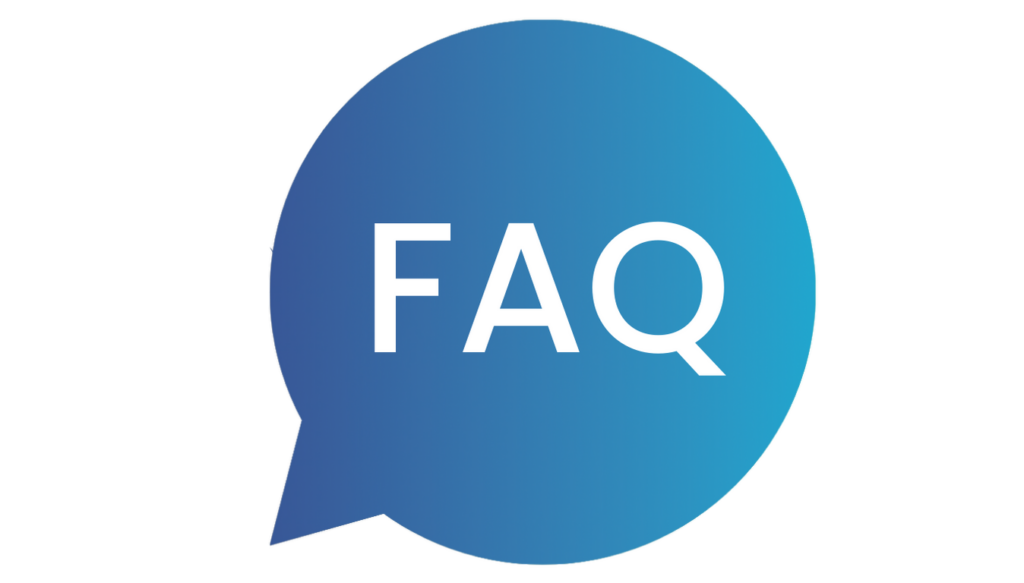
To become a VLSI engineer, you need a good foundation in digital electronics. Proficiency in hardware description languages (HDL) like Verilog or VHDL and programming skills are essential for designing and verifying circuits. Strong problem-solving and analytical thinking skills help in optimizing designs.
Additionally, knowledge of simulation tools and debugging techniques can be beneficial. You should be comfortable to code
Yes! Our courses are designed to be beginner-friendly, with a structured curriculum that starts with the fundamentals before moving to advanced topics. Additionally, our trainers are available to assist you throughout your learning journey. Knowledge in programming helps in understanding the course.
Digital Design and Verification
This foundational course aims to investigate what a chip is , why companies would want to make them, and their evolution over the decades.
The course begins with a brief history of the chip, and then covers chip IO , binary system , arithmetic and its representation, combinational and sequential circuit and basic Verilog constructs. We then give a detailed introduction to digital design and digital design verification.
We end the course with a debugging challenge wherein a digital design with bugs is given and students need to find bugs and report through the portal. As the bugs are reported, updated digital design is given providing a real industry digital verification exposure.
- Last Updated 01/2025
- English
- English[Integrated]
What will you learn?
- What is chip, Why a company would develop a chip
- Digital Fundamentals
- Evolution of chip, Types of chips, Bus Interfaces
- HDL Design flow & Synthesis
- Role of Verification, Types of Verification
- Functional Verification

Price Rs.7400 (incl. of GST)
Instructor Vinod Kumar Gopinath
Duration 8 Weeks
Chapters 14
Learners 2500 students
This Course Includes
- 5 hours on-demand video
- Lab assignments
- Quizzes and Elaborate Questions
- Certificate of completion
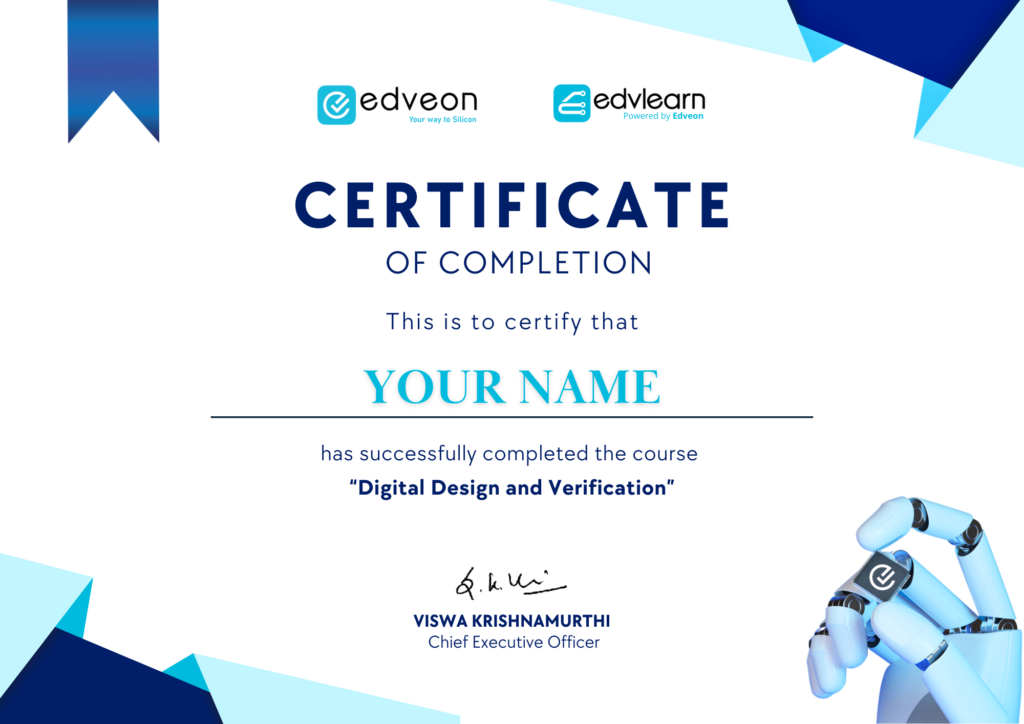
Certificate for completion (80%):
The certificate will state:
“This is to certify that (Name) has actively participated in the course ‘Digital Design and Verification’ and completed a major portion of the curriculum”
Certificate for completion (95% or more):
The certificate will state:
“This is to verify that(Name) has successfully completed the course ‘Digital Design and Verification'”
Course Curriculum
14 Chapters 74 Lectures 5h total length
Video Preview with Icon What is a Chip? ________________________________________ 7 lectures 18min
What is a Chip? ________________________________________ 7 lectures 18min
- Introduction------------02:12
-
Discrete and
continuous signals--- -- 02:14 - Digitization-------------02:27
-
Analog and digital
circuits---------------- 02:05 - Digital part of the chip---01:53
- Transistors-------------03.50
- Building digital systems with transistors -------------04.21
Preview
Preview
Video Preview with Icon Chip making process
and its evolution? _________________________________________ 4 lectures 11min
Chip making process
and its evolution? _________________________________________ 4 lectures 11min
- Chip evolution 1980-90--03.09
- Chip evolution 2000s----02:24
- Chip evolution 2010s- ---02:58
- Chip evolution 2020s----03:45
Video Preview with Icon Why chip?___________________________________________________________ 4 lectures 14min
Why chip?___________________________________________________________ 4 lectures 14min
- Chip making process----05:41
- Why chip?--------------03:00
- FPGA------- -----------02:45
- Comparing solutions-- --03:34
Preview
Video Preview with Icon Chip IO_________-__________________________________ 5 lectures 17min
Chip IO_________-__________________________________ 5 lectures 17min
- Input-output Pins-------02:59
-
IO pads, bus and
protocol--------------- 02:48 -
Arithmetic Logic
Unit(ALU) -------------- 04:21 -
Standard protocols
used in a chip---------- 04:07 - Chip categories-------- 03:50
Preview
Video Preview with Icon Binary system and arithmetic_____________________________ 5 lectures 18min
Binary system and arithmetic_____________________________ 5 lectures 18min
- What is binary system?--03:23
-
Representing negative
numbers in binary
system---------------- 04:07 -
Representing fractional
values in binary system--05:19 -
Weighted and
non-weighted code-----02:37 - Binary arithmetic--------03:17
Preview
Video Preview with Icon Logic gates and
optimization __________________________________ 5 lectures 17min
Logic gates and
optimization __________________________________ 5 lectures 17min
- Introduction to gates----03:11
- Processing logic gates- -02:11
-
Designing a solution
using processing
logic gates-------------04:13 -
Designing a solution
using processing
logic gates II -----------03:30 -
Optimizing boolean
equations--------------04:36
Preview
Video Preview with Icon Types of circuits ________________________________________ 5 lectures 17min
Types of circuits ________________________________________ 5 lectures 17min
-
Introduction to
combinational circuits----03:53 -
Examples of
combinational circuits----03:31 - Sequential circuits -------04:36
-
Sequential circuits - flip
flops--------------------03:56 - Setup and hold times-----02:40
Preview
Video Preview with Icon HDL design constructs ____________ Reference _______ </> Lab ________________________ 8 lectures 26min
HDL design constructs ____________ Reference _______ </> Lab ________________________ 8 lectures 26min
-
Hardware Description
Language---------------03:15 - Evolution of HDL----------03:00
-
Software language vs.
HDL---------------------02:51 -
Verilog constructs -
assign, always-----------05:27 - Verilog basics----------- 03:47
- Types of HDL coding------03:58
-
Verification constructs in
verilog--------------- -- 02:05 - Time and events---------03:06
Preview
Video Preview with Icon Digital design_____________________ Reference _ _ </> Lab ______________ 7 lectures 27min
Digital design_____________________ Reference _ _ </> Lab ______________ 7 lectures 27min
- Digital design initiation---04:03
-
Digital design of an
adder------------------05:45 -
Flow of control in the
design of an adder ------03:16 -
Digital design of traffic
controller---------------04:25 - Finite State Machines ----03:13
-
Configurability of a
state machine---------- 03:34 - Pipeline---------------- 03:32
Preview
Video Preview with Icon Aspects of a design _____________________________________ 7 lectures 19min
Aspects of a design _____________________________________ 7 lectures 19min
-
Control Status Register -
CSR--------------------04:24 -
Synchronous design and
CDC------------------- 04:41 - Memories in a chip------ 03:58
- IO in a chip - flip flops----04:13
-
Chiplets and their IO
protocol----------------03:52 - Categories of chips------02:51
- Synthesis---------------03:34
Preview
Video Preview with Icon Verification _______________________________________ 4 lectures 19min
Verification _______________________________________ 4 lectures 19min
- What is verification ------03:18
-
Verification in chip
making stages - 1--------03:34 -
Verification in chip
making stages - 2 -------03:47 -
Verification in chip
making stages - 3 -------03:36
Preview
Video Preview with Icon Functional verification______________________ 7 lectures 19min
Functional verification______________________ 7 lectures 19min
-
Functional verification
at a high level-----------02:34 -
Three independent
dimensions in functional verifcation--------------02:25 -
Phases in functional
verifcation and verification planning---------------03:59 - Testbench development-02:51
-
Test writing and
simulation -------------03:32 - Debug and regression --03:04
- Coverage closure ------02:29
Preview
Video Preview with Icon Testbench coding _______________________________________ </> Lab __ 6 lectures 19min
Testbench coding _______________________________________ </> Lab __ 6 lectures 19min
- FIFO - Specification ------03:39
- FIFO - Test Plan----------03:04
-
FIFO - Procedural
Testbench I------------ -07:15 -
FIFO - Procedural
Testbench II-------------03:39 -
FIFO - Procedural
Testbench III ------------05:37 - ALU - Procedural Testbench Exercise
Preview
How it works?
Meet Your Instructor
Vinod Kumar Gopinath
Vinod has nearly 30 years of experience in the software and hardware industry. During this time, he has also spent many years teaching students at schools, colleges, and organizations.
In this course, Vinod has combined his experience in teaching with his understanding of the VLSI industry.


Register
Sign up to gain access to the course
Faculty Allocation
After enrolling in the course, a dedicated faculty will be assigned to guide and support
Learn and Apply
Complete the course videos, exercises, and the exam.
Get Certified
Share your certificates on LinkedIn and enhance your professional growth
Pre-requisite
- Basics of Digital Electronics
- Knowledge and coding experience in C language
Requirements

To become a VLSI engineer, you need a good foundation in digital electronics. Proficiency in hardware description languages (HDL) like Verilog or VHDL and programming skills are essential for designing and verifying circuits. Strong problem-solving and analytical thinking skills help in optimizing designs.
Additionally, knowledge of simulation tools and debugging techniques can be beneficial. You should be comfortable to code
Yes! Our courses are designed to be beginner-friendly, with a structured curriculum that starts with the fundamentals before moving to advanced topics. Additionally, our trainers are available to assist you throughout your learning journey. Knowledge in programming helps in understanding the course.
Digital Design and Verification
- Last Updated 01/2025
- English
- English[Integrated]
This foundational course aims to investigate what a chip is , why companies would want to make them, and their evolution over the decades.
The course begins with a brief history of the chip, and then covers chip IO , binary system , arithmetic and its representation, combinational and sequential circuit and basic Verilog constructs. We then give a detailed introduction to digital design and digital design verification.
We end the course with a debugging challenge wherein a digital design with bugs is given and students need to find bugs and report through the portal. As the bugs are reported, updated digital design is given providing a real industry digital verification exposure.
What will you learn?
- What is chip, Why a company would develop a chip
- Digital Fundamentals
- Evolution of chip, Types of chips, Bus interface
- HDL Design flow & Synthesis
- Role of Verification, Types of verification
- Functional Verification

Price Rs.7400 (inclusive of GST)
Instructor Vinod Kumar Gopinath
Duration 8 Weeks
Chapters 14
Learners 2500 students
This Course Includes:
- 5 hours on-demand video
- Lab assignments
- Quizzes and Elaborate Questions
- Certificate of completion



Certificate for completion (80%):
The certificate will state:
“This is to certify that (Name) has actively participated in the course ‘Digital Design and Verification’ and completed a major portion of the curriculum”
Certificate for completion (95% or more):
The certificate will state:
“This is to verify that(Name) has successfully completed the course ‘Digital Design and Verification'”
Course Curriculum
14 Chapters 74 Lectures 5h total length
Preview
Video Preview with Icon What is a Chip? ______________________________________________________ 7 lectures 18min
What is a Chip? ______________________________________________________ 7 lectures 18min
- Introduction -----------------------------------------------------------02:12
- Discrete and continuous signals----------------------------------------- 02:14
- Digitization ------------------------------------------------------------02:27
- Analog and digital Circuits - -------------------------------------------- 02:05
- Digital part of the chip------------------------------------------------- -01:53
- Transistors - -----------------------------------------------------------03.50
- Building digital systems with transistors -----------------------------------04.21
Video Preview with Icon Chip making process and its evolution? __________________________ _ 4 lectures 11min
Chip making process and its evolution? __________________________ _ 4 lectures 11min
- Chip evolution 1980-90--------------------------------------------------03.09
- Chip evolution 2000s----------------------------------------------------02:24
- Chip evolution 2010s-------------- --------------------------------------02:58
- Chip evolution 2020s----------------------------------------------------03:45
Preview
Video Preview with Icon Why chip?_________________________________________________________ __ 4 lectures 14min
Why chip?_________________________________________________________ __ 4 lectures 14min
- Chip making process----------------------------------------------------05:41
- Why chip? ------------------------------------------------------ -------03:00
- FPGA - -----------------------------------------------------------------02:45
- Comparing solutions - ---------------------------------------------------03:34
Preview
Video Preview with Icon Chip IO__________-____________________________________________________ 5 lectures 17min
Chip IO__________-____________________________________________________ 5 lectures 17min
- Input-output Pins ------------------------------------------------------- 02:59
- IO pads, bus and protocol----------------------------------------------- -02:48
- Arithmetic Logic Unit(ALU)------------------------------------------------ 04:21
- Standard protocols used in a chip-----------------------------------------04:07
- Chip categories------------------------------------------------- --------03:50
Preview
Video Preview with Icon Binary system and arithmetic________________________________________ 5 lectures 18min
Binary system and arithmetic________________________________________ 5 lectures 18min
- What is binary system?---------------------------------------------------03:23
- Representing negative numbers in binary system--------------------------- 04:07
- Representing fractional values in binary system-----------------------------05:19
- Weighted and non-weighted code--------------------------------------- -02:37
- Binary arithmetic --------------------------------------------------------03:17
Preview
Video Preview with Icon Logic gates and optimization _______________________________________ 5 lectures 17min
Logic gates and optimization _______________________________________ 5 lectures 17min
- Introduction to gates-----------------------------------------------------03:11
- Processing logic gates--------------------------------------------------- 02:11
- Designing a solution using processing logic gates---------------------------04:13
- Designing a solution using processing logic gates II -------------------------03:30
- Optimizing boolean equations-------------------------------------------- 04:36
Preview
Video Preview with Icon Types of circuits _____________________________________________________ 5 lectures 17min
Types of circuits _____________________________________________________ 5 lectures 17min
- Introduction to combinational circuits-------------------------------------03:53
- Examples of combinational circuits--------------------------------------- 03:31
- Sequential circuits ------------------------------------------------------04:36
- Sequential circuits - flip flops---------------------------------------------03:56
- Setup and hold times----------------------------------------------------02:40
Preview
Video Preview with Icon HDL design constructs __________________ Reference __ </> Lab _ 8 lectures 26min
HDL design constructs __________________ Reference __ </> Lab _ 8 lectures 26min
- Hardware Description Language------------------------------------------03:15
- Evolution of HDL---------------------------------------------------------03:00
- Software language vs. HDL -------------------------------------------- - -02:51
- Verilog constructs - assign, always----------------------------------------05:27
- Verilog basics-----------------------------------------------------------03:47
- Types of HDL coding----------------------------------------------------- 03:58
- Verification constructs in verilog ------------------------------------------02:05
- Time and events-------------------------------------------------------- 03:06
Preview
Video Preview with Icon Digital design ___________________________ Reference _ _ </> Lab _ 7 lectures 27min
Digital design ___________________________ Reference _ _ </> Lab _ 7 lectures 27min
- Digital design initiation-------------------------------------------------- 04:03
- Digital design of an adder----------------------------------------------- 05:45
- Flow of control in the design of an adder ---------------------------------- 03:16
- Digital design of traffic controller----------------------------------------- 04:25
- Finite State Machines----------------------------------------------------03:13
- Configurability of a state machine----------------------------------------03:34
- Pipeline-------------------------------------------------------------- - 03:32
Preview
Video Preview with Icon Aspects of a design __________________________________________________ 7 lectures 19min
Aspects of a design __________________________________________________ 7 lectures 19min
- Control Status Register - CSR--------------------------------------------- 04:24
- Synchronous design and CDC--------------------------------------------04:41
- Memories in a chip------------------------------------------------------03:58
- IO in a chip - flip flops--------------------------------------------------- 04:13
- Chiplets and their IO protocol --------------------------------------------03:52
- Categories of chips----------------------------------------------------- 02:51
- Synthesis --------------------------------------------------------------03:34
Preview
Video Preview with Icon Verification ___________________________________________________________ 4 lectures 19min
Verification ___________________________________________________________ 4 lectures 19min
- What is verification -----------------------------------------------------03:18
- Verification in chip making stages - 1------------------------------------- 03:34
- Verification in chip making stages - 2-------------------------------------03:47
- Verification in chip making stages - 3-------------------------------------03:36
Preview
Video Preview with Icon Functional verification________________________________________________ 7 lectures 19min
Functional verification________________________________________________ 7 lectures 19min
- Functional verification at a high level--------------------------------------02:34
- Three independent dimensions in functional verifcation---------------------02:25
- Phases in functional verifcation and verification planning------------------- 03:59
- Testbench development-------------------------------------------------02:51
- Test writing and simulation ----------------------------------------------03:32
- Debug and regression---------------------------------------------------03:04
- Coverage closure-------------------------------------------------------02:29
Preview
Video Preview with Icon Testbench coding _______________________________________ </> Lab _ _ 6 lectures 19min
Testbench coding _______________________________________ </> Lab _ _ 6 lectures 19min
- FIFO - Specification -----------------------------------------------------03:39
- FIFO - Test Plan---------------------------------------------------------03:04
- FIFO - Procedural Testbench I-------------------------------------------- 07:15
- FIFO - Procedural Testbench II--------------------------------------------03:39
- FIFO - Procedural Testbench III------------------------------------------- 05:37
- ALU - Procedural Testbench Exercise
Preview
Video Preview with Icon Debugging challenge _ __________________________________</> Lab
Debugging challenge _ __________________________________</> Lab
- FIFO - Debug
- FSM - Debug
Meet Your Instructor
Pre-requisite
Basics of Digital Electronics
Knowledge and coding experience in C language
Requirements
Vinod Kumar Gopinath
Vinod has nearly 30 years of experience in the software and hardware industry. During this time, he has also spent many years teaching students at schools, colleges, and organizations.
In this course, Vinod has combined his experience in teaching with his understanding of the VLSI industry.
How it works?


How it works?
Faculty Allocation
After enrolling in the course, a dedicated faculty will be assigned to guide and support
Register
Sign up to gain access to the course
Faculty Allocation
After enrolling in the course, a dedicated faculty will be assigned to guide and support
Learn and Apply
Complete the course videos, exercises, and the exam.
Get Certified
Share your certificates on LinkedIn and enhance your professional growth

To become a VLSI engineer, you need a good foundation in digital electronics. Proficiency in hardware description languages (HDL) like Verilog or VHDL and programming skills are essential for designing and verifying circuits. Strong problem-solving and analytical thinking skills help in optimizing designs.
Additionally, knowledge of simulation tools and debugging techniques can be beneficial. You should be comfortable to code
Yes! Our courses are designed to be beginner-friendly, with a structured curriculum that starts with the fundamentals before moving to advanced topics. Additionally, our trainers are available to assist you throughout your learning journey. Knowledge in programming helps in understanding the course.

